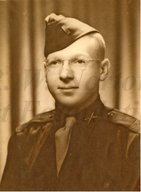
|

|
|
|
|
John, who goes by his nickname, "Roy," was born in Elm Grove, Louisiana, as one of three children of Arthur Leroy and Alma Garland Horton, a school teacher. He grew up on a Bossier Parish plantation where his father, a World War I veteran, worked as overseer. Roy brought water to the "hoe hands" and "cotton pickers." He also picked cotton, but admits, "I wasn't very good at that." Roy recalls the Great Depression as a time when "we didn't get a lot of new clothes and shoes," although the family always had "plenty to eat." He recalls his boyhood home as having high ceilings and three porches, including a sleeping porch. The family owned a battery-operated Philco radio. While Roy enjoyed listening to programs such as Fibber McGee and Molly and Jack Armstrong: All-American Boy, the family kept up with the news on the radio and from The Shreveport Times and The Shreveport Journal. Growing up in a house beside a bayou, he enjoyed a boyhood spent in the outdoors. He "made rafts and shot snakes and skipped rocks." He hunted squirrels and birds, and often shot ducks from a nine-foot long pirogue. Roy spent many weekends on Lake Bistineau, where his father, after purchasing ten acres, built a camp house and rented boats. Roy sold soft drinks, candy, peanuts, and popcorn from a stand he called "Roy's Place." On busy July 4th weekends, he recalls selling "seventy to eighty cases of Cokes at a nickel a bottle." Roy was a member of 4-H and the Boy Scouts. He graduated as salutatorian in the spring of 1941 from Elm Grove High School. That fall Roy enrolled at Texas A&M University where he was a member of the Corps of Cadets and began studying for an engineering degree. He recalls going to the movies in Bryan on December 7, 1941, and returning to his dormitory to see banners hanging out windows that read, "Beat the Japs" and "Beat the Hell Out of Japan." He then learned of the attack on Pearl Harbor. Roy entered active duty on June 1, 1943 and was sent to Fort Riley, Kansas, for basic training. He claims the discipline at A&M, however, as "a lot worse" than in basic training. In fall of 1943 he was sent to Laramie, Wyoming as part of the Army Special Training Program (ASTP) where he took mechanical engineering. He also went to the University of Minnesota for a semester. After the ASTP was shut down in 1944, Roy was assigned to the Army Marine Ship Repair Company--one of ten such companies (five each in the Pacific and European theaters) that repaired Army-owned watercraft. Roy was sent overseas on August 25, 1944 to Milne Bay, New Guinea, where he worked as an engine mechanic. Often he toiled in steamy conditions beneath steel decks where temperatures reached 140 degrees. "You'd take off everything you could and you'd go down there and work maybe thirty minutes and then you'd have to come out and cool off," he says. As U.S. forces made progress against the Japanese, he was sent on to Hollandia, New Guinea, where he received orders to attend a five-month Officer Candidate School in Australia, beginning in January of 1945. He admired the instructors, he recalls, who had served in combat. Roy finished OCS in May of 1945 and was attached to U.S. Army Training Group in Manila. He was sent to Negros Island to train the 53rd Philippine Infantry. He served as weapons officer and taught map reading and hand-to-hand combat. Most of the Filipino infantryman, he recalls, had fought as guerillas. "I had great respect for them," he says. Roy says the island was still "infested with Japanese who didn't know the war was over." He recalls meeting an Irish Catholic priest, Father Gallagher, who had been crucified on a tree at the hands of Japanese soldiers. The priest survived, and later ministered to Japanese prisoners. Roy was promoted to commanding officer of a company in the 45th Infantry of the 12th Division of Philippine Scouts on Luzon before his tour of duty ended. Back in America by August 12, 1946, Roy left service at Fort Sam Houston in San Antonio, although he would remain in the reserves for eight years. On the way home he stopped at Texas A&M University and enrolled for the coming semester on the GI Bill. "I came home, unloaded my duffel bag, and went right back to College Station and started school in September," he recalls. After graduating he worked for Chevron as an engineer in construction and maintenance in Mississippi. While living in Waterproof, Louisiana, he met and married Lillian Johnson, or "Sally," as she was called, in September of 1948. They would have three children, seven grandchildren, and two great-grandchildren. The family moved to Shreveport where Roy spent thirty years at Beaird Company. He later worked as a consultant for 21 years. In 1982, Roy earned a doctorate from Louisiana Tech. |


